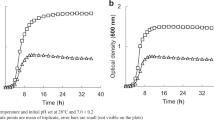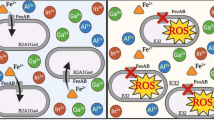Abstract
Large-scale industrial use of chromium (Cr) resulted in widespread environmental contamination with hexavalent chromium (Cr(VI)). The ability of microorganisms to survive in these environments and detoxify chromate requires the presence of specific resistance systems. Several Cr(VI) resistant species, belonging to a variety of genera, have been isolated in recent years. Ochrobactrum tritici strain 5bvl1 is a model for a highly Cr(VI)-resistant and reducing microorganism, with different strategies to cope with chromium. The strain contains the transposon-located (TnOtChr) chromate resistance genes chrB, chrA, chrC, chrF. The chrB and chrA genes were found to be essential for the establishment of high resistance but not chrC or chrF genes. Other mechanisms involved in chromium resistance in this strain were related to strategies such as specific or unspecific Cr(VI) reduction, free-radical detoxifying activities, and repairing DNA damage. Expression of the chrB, chrC or chrF genes was related to increased resistance to superoxide-generating agents. Genetic analyses also showed that, the ruvB gene is related to chromium resistance in O. tritici 5bvl1. The RuvABC complex probably does not form when ruvB gene is interrupted, and the repair of DNA damage induced by chromium is prevented. Aerobic or anaerobic chromate reductase activity and other unspecific mechanisms for chromium reduction have been identified in different bacteria. In the strain O. tritici 5bvl1, several unspecific mechanisms were found. Dichromate and chromate have different effects on the physiology of the chromium resistant strains and dichromate seems to be more toxic. Toxicity of Cr(VI) was evaluated by following growth, reduction, respiration, glucose uptake assays and by comparing cell morphology.






Similar content being viewed by others
References
Ackerley DF, Gonzalez CF, Park CH, Blake R, Keyhan M, Matin A (2004) Mechanism of chromate reduction by the Escherichia coli protein, NfsA, and the role of different chromate reductases in minimizing oxidative stress during chromate reduction. Environ Microbiol 6:851–860
Ackerley DF, Barak Y, Lynch SV, Curtin J, Matin A (2006) Effect of chromate stress on Escherichia coli K-12. J Bacteriol 188:3371–3381
Aguilar-Barajas E, Paluscio E, Cervantes C, Rensing C (2008) Expression of chromate resistance genes from Shewanella sp. strain ANA-3 in Escherichia coli. FEMS Microbiol Lett 285:97–100
Alvarez AH, Moreno-Sánchez R, Cervantes C (1999) Chromate efflux by means of the ChrA chromate resistance protein from Pseudomonas aeruginosa. J Bacteriol 181:7398–7400
Bopp LH, Erlich HL (1988) Chromate resistance and reduction in Pseudomonas fluorescens strain LB300. Arch Microbiol 150:426–431
Branco R, Morais PV (2006) Identification of genes involved in oxyanions resistance in Ochrobactrum tritici 5bvl1 by transposon mutagenesis. Met Ions Biol Med 9:205–209
Branco R, Alpoim MC, Morais PV (2004) Ochrobactrum tritici strain 5bvl1: characterization of a Cr(VI)-resistant and Cr(VI)-reducing strain. Can J Microbiol 50:697–703
Branco R, Chung AP, Johnston T, Gurel V, Morais PV, Zhitkovich A (2008) The chromate-inducible chrBACF operon from the transposable element TnOtChr confers resistance to chromium(VI) and superoxide. J Bacteriol 190:6996–7003
Branco R, Francisco R, Chung AP, Morais PV (2009) Identification of an aox system that requires cytochrome c in the highly arsenic-resistant bacterium Ochrobactrum tritici SCII24. Appl Environ Microbiol 75:5141–5147
Camargo FAO, Okeke BC, Bento FM, Frankenberger WT (2003) In vitro reduction of hexavalent chromium by a cell-free extract of Bacillus sp. ES 29 stimulated by Cu2+. Appl Microbiol Biotechnol 62:569–573
Cervantes C, Campos-Garcia J (2007) Reduction and efflux of chromate by bacteria. In: Nies DH, Silver S (eds) Molecular microbiology of heavy metals. Microbiol monographs, vol 6. Springer-Verlag, Berlin Heidelberg, pp 407–419
Cervantes C, Ohtake H (1988) Plasmid-determined resistance to chromate in Pseudomonas aeruginosa. FEMS Microbiol Lett 56:173–176
Cervantes C, Ohtake H, Chu L, Misra TK, Silver S (1990) Cloning, nucleotide sequence, and expression of the chromate resistance determinant of Pseudomonas aeruginosa plasmid pUM505. J Bacteriol 172:287–291
Cervantes C, Campos-Garcia J, Devars S, Gutierrez-Corona F, Loza-Tavera H, Torres-Guzman JC, Moreno-Sanchez R (2001) Interactions of chromium with microorganisms and plants. FEMS Microbiol Rev 25:335–347
Chardin B, Giudici-Orticoni M-T, De Luca G, Guigliarelli B, Bruschi M (2003) Hydrogenases in sulfate-reducing bacteria function as chromium reductase. Appl Microbiol Biotechnol 63:315–321
Chourey K, Wei W, Wan X-F, Thompson DK (2008) Transcriptome analysis reveals response regulator SO2426-mediated gene expression in Shewanella oneidensis MR-1 under chromate challenge. BMC Genomics 9:395
Costa M (2003) Potential hazards of hexavalent chromium in our drinking water. Toxicol Appl Pharmacol 188:1–5
Daulton TL, Little BJ, Lowe K, Jones-Meehan J (2001) In situ environmental cell-transmission electron microscopy study of microbial reduction of chromium(VI) using electron energy loss spectroscopy. Microsc Microanal 7:470–485
Decorosi F, Tatti E, Mini A, Giovannetti L, Viti C (2009) Characterization of two genes involved in chromate resistance in a Cr(VI)-hyper-resistant bacterium. Extremophiles 13:917–923
Díaz-Magaña A, Aguilar-Barajas E, Moreno-Sánchez R, Ramírez-Díaz MI, Riveros-Rosas H, Vargas E, Cervantes C (2009) Short-chain chromate ion transporter proteins from Bacillus subtilis confer chromate resistance in Escherichia coli. J Bacteriol 191(17):5441–5445
Dodd IB, Egan JB (1990) Helix-turn-helix DNA-binding motifs prediction. Improved detection of helix-turn-helix DNA-binding motifs in protein sequences. Nucleic Acids Res 18:5019–5026
Elangovan R, Abhipsa S, Rohit B, Ligy P, Chandraraj K (2006) Reduction of Cr(VI) by a Bacillus sp. Biotechnol Lett 28:247–252
Francisco R, Alpoim MC, Morais PV (2002) Diversity of chromium-resistant and reducing bacteria in a chromium-contaminated activated sludge. J Appl Microbiol 92:837–843
Francisco R, Moreno A, Alpoim MC, Morais PV (2006) Cr(VI) effect on Ochrobactrum tritici strain 5bvl1 respiration capacity. Met Ions Biol Med 9:256–259
Francisco R, Moreno A, Morais PV (2010) Different physiological responses to chromate and dichromate in the chromium resistant and reducing strain Ochrobactrum tritici 5bvl1. Biometals 23:713–725
Hanukoglu I, Rapoport R (1995) Routes and regulation of NADPH production in steroidogenic mitochondria. Endocr Res 21:231–241
He M, Li X, Guo L, Miller SJ, Rensing C, Wang G (2010) Characterization and genomic analysis of chromate resistant and reducing Bacillus cereus strain SJ1. BMC Microbiol 10:221
He M, Li X, Liu H, Miller SJ, Wang G, Rensing C (2011) Characterization and genomic analysis of a highly chromate resistant and reducing bacterial strain Lysinibacillus fusiformis ZC1. J Hazard Mater 185:682–688
Henne KL, Nakatsu CH, Thompson DK, Konopka AE (2009) High-level chromate resistance in Arthrobacter sp. strain FB24 requires previously uncharacterized accessory genes. BMC Microbiol 9:199
Hu P, Brodie EL, Suuki Y, McAdams HH, Andersen GL (2005) Whole-genome transcriptional analysis of heavy metal stresses in Caulobacter crescentus. J Bacteriol 187:8437–8449
Juhnke S, Peitzsch N, Hübener N, Grosse C, Nies DH (2002) New genes involved in chromate resistance in Ralstonia metallidurans strain CH34. Arch Microbiol 179:15–25
Kagan VE, Fabisiak JP, Shvedova AA, Tyurina YY, Tyurin VA, Schor NF, Kawai K (2000) Oxidative signalling pathway for externalization of plasma membrane phosphatidylserine during apoptosis. FEBS Lett 477:1–7
Konopka A, Zakharova T (1999) Quantification of bacterial lead resistance via activity assays. J Microbiol Methods 37:17–22
Kwak YH, Lee DS, Kim HB (2003) Vibrio harveyi nitroreductase is also a chromate reductase. Appl Environ Microbiol 69:4390–4395
Li B, Pan D, Zheng J, Cheng Y, Ma X, Huang F, Lin Z (2008) Microscopic investigations of the Cr(VI) uptake mechanism of living Ochrobactrum anthropi. Langmuir 24:9630–9635
Llagostera M, Garrido S, Guerrero R, Barbé J (1986) Induction of SOS genes of Escherichia coli by chromium compounds. Environ Mutagen 8:571–577
Ma Y-F, Wu J-F, Wang S-Y, Jiang C-Y, Zhang Y, Qi S-W, Liu L, Zhao G-P, Liu S-J (2007) Nucleotide sequence of plasmid pCNB1 from Comamonas strain CNB-1 reveals novel genetic organization and evolution for 4-chloronitrobenzene degradation. Appl Environ Microbiol 77:4477–4483
McLean J, Beveridge TJ (2001) Chromate reduction by pseudomonad isolated from a site contaminated with chromated copper arsenate. Appl Environ Microbiol 67:1076–1084
Mehta T, Coppi MV, Childers SE, Lovley DR (2005) Outer membrane c-type cytochromes required for Fe(III) and Mn(IV) oxide reduction in Geobacter sulfurreducens. Appl Environ Microbiol 71:8634–8641
Messer J, Reynolds M, Stoddard L, Zhitkovich A (2006) Causes of DNA single-strand breaks during reduction of chromate by glutathione in vitro and in cells. Free Radic Biol Med 40:1981–1992
Miranda AT, González MV, González G, Vargas E, Campos-García J, Cervantes C (2005) Involvement of DNA helicases in chromate resistance by Pseudomonas aeruginosa PAO1. Mutat Res 578:202–209
Mondaca MA, González CL, Zaror CA (1998) Isolation, characterization and expression of a plasmid encoding chromate resistance in Pseudomonas putida KT2441. Lett Appl Microbiol 26:367–371
Nies A, Nies DH, Silver S (1989) Cloning and Expression of plasmid genes encoding resistances to chromate and cobalt in Alcaligenes eutrophus. J Bacteriol 171:5065–5070
Nies A, Nies DH, Silver S (1990) Nucleotide sequence and expression of a plasmid-encoded chromate resistance determinant from Alcaligenes eutrophus. J Biol Chem 265:5648–5653
Nies DH, Rehbein G, Hoffmann T, Baumann C, Grosse C (2006) Paralogs of genes encoding metal resistance proteins in Cupriavidus metallidurans strain CH34. J Mol Microbiol Biotechnol 11:82–93
Peitzsch N, Eberz G, Nies DH (1998) Alcaligenes eutrophus as a bacterial chromate sensor. Appl Environ Microbiol 64:453–458
Pimentel BE, Moreno-Sánchez R, Cervantes C (2002) Efflux of chromate by Pseudomonas aeruginosa cells expressing the ChrA protein. FEMS Microbiol Lett 212:249–254
Ramírez-Díaz MI, Díaz-Pérez C, Vargas E, Riveros-Rosas H, Campos-García J Cervantes C (2008) Mechanisms of bacterial resistance to chromium compounds. Biometals. doi:10.1007/s10534-007-9121-8
Ramsey JD, Xia L, Kendig MW, McCreery RL (2001) Raman spectroscopic analysis of the speciation of dilute chromate solutions. Corros Sci 43:1557–1572
Reynolds MF, Peterson-Roth EC, Jonhston T, Gurel VM, Menard HL, Zhitkovich A (2009) Rapid DNA double-strand breaks resulting from processing of Cr-DNA crosslinks by both MutS dimers. Cancer Res 69:1071–1079
Shen H, Wang Y-T (1993) Characterization of enzymatic reduction of hexavalent chromium by Escherichia coli ATCC 33456. Appl Environ Microbiol 59:3771–3777
Sugiyama M (1994) Role of paramagnetic chromium in chromium(VI)-induced damage in cultured mammalian cells. Environ Health Perspect 102(Suppl 3):31–33
Tauch A, Schlüter A, Bischoff N, Goesmann A, Meyer F, Pühler A (2003) The 79, 370-bp conjugative plasmid pB4 consists of an IncP-1beta backbone loaded with a chromate resistance transposon, the strA-strB streptomycin resistance gene pair, the oxacillinase gene bla(NPS-1), and a tripartite antibiotic efflux system of the resistance-nodulation-division family. Mol Genet Genomics 268:570–584
Wang PC, Mori J, Toda K, Ohtake H (1990) Membrane-associated chromate reductase activity from Enterobacter cloacae. J Bacteriol 172:1670–1672
Acknowledgments
This research was founded by Fundação para a Ciência e Tecnologia (FCT), Portugal (PTDC/MAR/109057/2008). Rita Branco was supported by PostDoc grant from FCT (SFRH/BPD/48330/2008).
Author information
Authors and Affiliations
Corresponding author
Rights and permissions
About this article
Cite this article
Morais, P.V., Branco, R. & Francisco, R. Chromium resistance strategies and toxicity: what makes Ochrobactrum tritici 5bvl1 a strain highly resistant. Biometals 24, 401–410 (2011). https://doi.org/10.1007/s10534-011-9446-1
Received:
Accepted:
Published:
Issue Date:
DOI: https://doi.org/10.1007/s10534-011-9446-1




